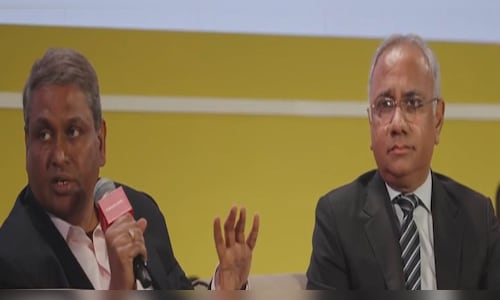Parekh highlighted that AI-driven advancements in software development are boosting productivity by 7% to 15%. However, AI is not just about efficiency. “We also see new work. There is new work in credit analysis we are doing with a client, which we would never have done had it not been for generative AI,” he noted.
He added that while these new opportunities expand the market, improved productivity enhances overall efficiency.
Vijayakumar stressed the need to shift from an input-based to an output-based model, using AI and automation to achieve more with fewer resources.
These are the edited excerpts of the interview.
Q: We are living in an era of uncertainty, of revolutionary technology changes. Artificial Intelligence (AI), quantum computing and so on and so forth. When I spoke with both of you in January this year in Davos, the mood was one of confidence and optimism. Would you continue to take that conversation forward? To start with the demand explosion, the questions that are being asked today on the mix for Indian IT services are whether this business model will continue to be relevant. Yes or no?
Vijayakumar: As I mentioned in Davos, I strongly believe that the business model is ripe for disruption. What we saw in the last 30 years is a fairly linear scaling of IT services, which scale with people and revenue scale very linearly. The time is already out for that model, and in the last couple of years, we have been challenging our teams on how you can deliver twice the revenue with half the people.
Also, Read | India’s tech industry to cross $300 billion by FY26, NASSCOM survey finds
That is the call that I have made to a lot of my teams. And it is definitely a big moment of disruption. All of us are seeing good demand. All of that is happening. That is a linear extrapolation of the current business model with different economic situations, your demand may go up and down, but what is fundamentally changing is something which we need to recognise and react to.
Q: That is an important statement. You said the time is out for this business model. What are we talking about then in terms of disruption? What are we talking about in terms of adaptability and innovation? Where does the industry find itself if you believe that time is in fact out for this business model?
Vijayakumar: A large part of the industry is driven by a very input-based model. It is either time or material. It is always a number of people delivering certain outcomes. But we need to dramatically change from input-based to more output and outcome-based. A lot of the operational services that we deliver from people-based, it needs to become platform-based. So we have always heard of software as a service, but service as a software is definitely taking place quite dramatically.
We all need to be more proactive in adopting. Whatever growth we are seeing in the business should not make us complacent because the underlying themes are not the same as cloud and digitisation and other things. This is very different. The changes that AI is ushering in are very different, and we need to be more proactive to even cannibalise our revenues to create completely new businesses.
Also Read | Davos 2025: Salil Parekh highlights Infosys’s strategy in a rapidly evolving tech world
Having said that, I remain quite optimistic about how we can reinvent. As long as you recognise the change is not the same as what we have seen maybe two decades, three decades ago, we are setting ourselves on a good fundamental basis to reinvent our industry.
Q: Before we came in, you said, there is no problem that we are faced with at this point. If I look at what CVK is saying, he is not suggesting that we don’t have a problem to deal with.
Parekh: I fully agree with what Vijayakumar is saying. The view that we see is there is a huge shift in technology, whether you look at generative AI, or quantum or several other technologies in motion today, which will impact where the world goes.
We, within Infosys, are ready to face that challenge. And it is exciting because you look at some of the new work that is going on, whether it is some startups through large businesses, it is all coming from India.
Q: But your revenues are not coming from India.
Parekh: Look at the innovation that we are driving. If you look at quantum we have work that we are doing, for example, in drug discovery using early quantum platforms. There are two large companies, both cloud-based and non-cloud-based, that have a good quantum platform. And we can already see examples of that. You look at it like a telecom network optimisation. We are seeing examples of that.
Also Read | Indian tech CEOs see stronger FY26; AI spend up, hiring outlook improves
This is all being done because we have a massive scale across India, across Infosys, whichever lens you put on it, and that helps to drive it. Very much agree that we have to be ready and not be complacent, that we have change coming upon us.
Q: Do you believe, with what Vijayakumar just said, that the time is up on the current business model?
Parekh: What I feel is what Vijayakumar is saying is a call for us to make sure we don’t remain complacent. There are aspects of what we are doing today that are growing well, and that will continue, but we need to find new ways. So if you look at AI, there is a massive productivity benefit we are seeing, for example, in software development, between 7% and 15% that is a huge number, and we use that in our product as an example.
But we also see new work. There is new work in credit analysis we are doing with a client, which we would never have done had it not been for generative AI. So there is new work, which expands the market, and there is productivity, which gives us efficiency. So both of those have to be taken into account. That is how I understood what Vijayakumar is saying. To make sure we are not complacent about it.
Q: Let us talk about the reinvention that you mentioned, Vijayakumar, and for the benefit of everybody sitting here, let us start by talking about what you have already started to work on, the measures that you have already taken as part of this reinvention and this arc, this transition from software as a service to service as a software. How ready are you today, and what will you need to do to make that transition?
Vijayakumar: The first and foremost change that we are driving within our organisation is the mindset change. We are all very used to a certain mindset of delivering certain value to clients, but that paradigm is changing.
You could deliver the same value, maybe with half the people, then you have to force yourself to think. Whatever human potential is unlocked, how can you use that to create more growth opportunities? That is the mindset shift that we need to make.
Also Read | Budget 2025: Nasscom wants government to help propel IT sector growth
All of us have growing businesses. We have people with a lot of aspirations. So how do you take care of people’s aspirations while being very proactive about adopting these technologies and bringing the highest level of productivity that is unlocked? How can the productivity that is unlocked be used to create more value and growth?
Q: How are you creating more value?
Vijayakumar: A number of examples. For a very large financial services firm, where we were delivering a transformation program, the client is spending maybe a billion dollars a year. It is a five-year program. We believe it can be done in three and a half years, and there is enough proof points that this can be done. But here the value is not in the 18 months that we will save, which, of course, is going to be significantly cost-effective for the client, but it’s the time to value. Whatever the policy modernisation they wanted to roll out, what is the time to value? That is where the biggest value creation is possible.
Q: We are talking about human genius and human ingenuity as well, and we were just talking about moving from people to platform. Now, what happens in the workforce? Because this is a sector that has been driving employment for a young demographic, like India? What happens to entry-level jobs over the next five years?
Parekh: First, in the existing employees that we have, there is huge reskilling. So there is a constant move, especially with generative AI. But all through when we were having digital or cloud or cyber, a lot of reskilling today, at least within Infosys, over 270,000 people more ready for AI. So that’s the first element.
Second, in terms of new roles we have already shared this last quarter. For the next financial year, starting April, we will recruit something like 15,000-20,000 new campus hires, which shows the same sort of direction of what we were discussing earlier, which is, there is growth, there is productivity, and there is new work from these technologies. All of that combined gives us confidence to have new people joining from the campus.
For the full interview, watch the accompanying video
Catch all the latest updates from the stock market here


